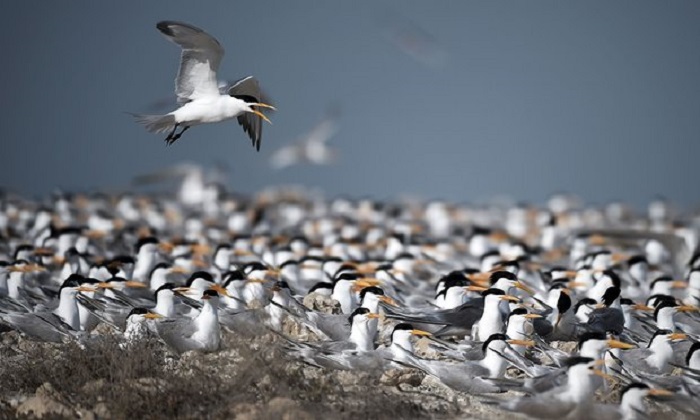“There was plenty of shock, it is a very unusual situation,” said Dr Martin Robards, Arctic program director at the Wildlife Conservation Society, which found the nest. “We checked with Caspian tern experts and they were all very surprised they were this far north. We get Arctic terns here but these terns are much bigger, they really stand out.”
The terns, usually found in Washington state, successfully bred and chicks have now flown the nest. While it remains to be seen whether Caspian terns will become ensconced long-term within the Arctic circle, the epic relocation is emblematic of how warming temperatures are causing a huge upheaval in the basic rhythms of Alaska’s environment. Next week, scientists will gather at the White House’s first ever Arctic science meeting to deliver the confronting news.
“I’ve been up here 25 years and the amount of change that has occurred in Alaska is shocking,” said Robards. “We’ve been focusing on things such as the temperature and sea ice here but now we are thinking ‘oh my God what is going on with the wildlife?’”
Alaska is warming at twice the rate of the rest of the US, with the winter temperature 6F (3.3C) warmer than it was 60 years ago. Snow and ice has retreated, spring is coming earlier. The landscape is changing and so are its residents.
“To be 1,000 miles further north attests to how much the globe has warmed,” said Terry Root, a biologist and senior fellow at Stanford University. “Birds follow their physiology, nothing else. If they think they should move, they move. Alaska has warmed so much that it is causing havoc to a lot of nature.”
While most species aren’t able to move as far as terns, scientists are noticing shifts across Alaska. Moose and beavers have moved north of the Brooks Range and onto the Arctic plain, which increasingly offers suitable vegetation as the region warms up and greens.
Red foxes have moved in and have started to outcompete Arctic foxes. A similar thing may happen if the beefy Caspian terns start to push out their smaller cousins. The relationship between grizzly bears and polar bears may be a little more amicable – as their range starts to overlap there have been reports of a hybrid “pizzly” bears in the Arctic.
But the situation for polar bears is otherwise grim – they are losing life-sustaining sea ice critical for hunting and breeding across the Arctic. They are being forced onto land, where they risk starvation. This desperate scenario is shared with walruses, which have already suffered a 50% drop since the 1980s. In recent years tens of thousands of the tusked beasts have had to crowd ashore, with many perishing in stampedes.
The melting on land is just as stark. Over the past decade, Alaska has lost 850 gigatonnes of water from its shrinking glaciers, enough to raise the global sea level by 2.9mm. We are living through the fastest Arctic glacier decline in at least 6,000 years, according to Dr Martin Sharp, professor of Earth and atmospheric science at the University of Alberta.
“If the warming trends continue then we expect to see continuous retreat,” Sharp said. “We are seeing the complete loss of glaciers, areas that had ice caps in the 1950s don’t have them now. That trend will probably increase.”
Alaska is being locked into an unhappy cycle of events. As the declining glaciers lose albedo, or reflectivity from sunlight, they absorb more heat and therefore melt further.
The vegetation poking through thawing permafrost aids the spread of wildfire which in turn releases more carbon dioxide – flames have recently licked areas of Alaskan forest previously unburned for thousands of years. The amount of area burned each year in the state is expected to double by 2050 even if the world acts swiftly on climate change.
Summer Arctic sea ice is forecast to winnow away completely by the 2030s, which will be a boon for tourism operators looking to traverse the opening north-west sea passage. The Crystal Serenity cruise ship, with passengers that paid up to $100,000 for a cabin, arrived safely in New York last week after a 32-day journey through this newly reliable corridor.
But this decline threatens more traditional pursuits. Indigenous communities are finding the thinning ice too treacherous for fishing, while the 1,000-mile Iditarod dog sled race faces an uncertain future. After record winter warmth, Alaska baked as the season turned to spring – the temperature from January to April was an incredible 11.3F (6.2C) warmer than the long-term average taken from the 20th century.
Still, Alaska and neighboring Canada may well prove a haven for overheated animal species in the future. The state will still be cooler than the lower 48 states and has plenty of wilderness.
“The Caspian tern is a success story in many ways,” said Root. “Unfortunately, many animals won’t be able to move. There’s only so far a salamander can crawl or a gopher tortoise can walk. We stand at the beginning of a mass extinction event.
“One of the most important wildlife corridors runs between Mexico and the US, so Donald Trump’s stupid wall could be a huge problem for nature. At least we won’t have a border like that with Canada, I guess.”
More about:
















































